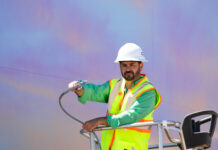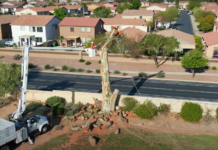Henry Morgan was born in Wisconsin in about 1841. He came from San Francisco to the Arizona Territory in 1864 as an engineer from San Francisco with contract in hand that directed him to build a steam flourmill at Casa Blanca.
At the time, the Pimas were growing huge amounts of superior wheat. Morgan had the difficult task of transporting the necessary equipment from San Francisco over rough trails and constructing a mill with inexperienced labor. However, he was successful and accomplished it in the allotted time of one year. After the mill was completed, Morgan worked at building a quartz mill in northern Arizona the following two years.
In 1867, he returned to the Maricopa Wells area and built a trading post and station called Morgan’s Ferry. Morgan’s Ferry was located northwest of Maricopa Wells. He spent the next several years working from this site, trading with the Pimas and ferrying wagons and teams of horses from Phoenix across the turbulent Gila River during flood season to connect with the railhead of Maricopa Wells. He allegedly wore out or lost four ferryboats during this time.
Morgan spoke highly of the Pimas. He described them as honest and fair. The Pima women were allowed to charge items at his trading post, but the Pima men thought this was humorous and laughed at him. Morgan said he had no problems with collecting from them. He said the Pimas and Maricopas always paid their bills whether their crops were successful or not. If they had a bad year of farming, the chief always came and assured him that the debts would be satisfied… and they always were.
However, Morgan appeared to have operated under a cloud of mystique by most white men. Rumors charged that he had been a pirate in the Gulf of California. Seventeen-year-old Charles Clark, the first telegrapher at Maricopa Wells, spent a considerable amount of time with Morgan after Aunt Jane at the “Wells” banned him from eating at her table. During his tutorage under Morgan, Clark not only learned to cook, but also developed a variety of other desert survival skills.
Clark described Morgan as, “Rough, blasphemous to a degree, but a fairly good fellow when he was not drunk. As a result of some fight he had been in, he claimed to have seven bullets in his body, three of them being plainly visible just under the skin.” Another rumor listed him as having led a group of Maricopas in a successful battle against invading Yumas in 1865. He was generally described as a man with few words and decided opinions, but had a kindly personally and was amiable and friendly if he liked you. Whatever his escapades, he was accepted and respected by those who knew him.
In July 1872 Henry Morgan built a store in Phoenix. He stocked it with merchandise and opened the door for business in August of 1872. An article in the Arizona Miner on Sept. 21, 1872, described this new building on the north side of East Washington Street in Phoenix.
“H. Morgan & Co., have finished their new building on Washington Street, joining on to the new building of John George so as to form but one structure. A piazza extends along the whole front built entirely of sawed lumber, neat and tasty in appearance, and with the trees in front, their rich green foliage forming a natural curtain, it is a pleasant place in which to loaf.”
The Phoenix business was located on the same ground that later was occupied by the Goldberg Brothers (1918) and Woolworths. However, it suffered heavy damage through fire in 1886, and the company eventually collapsed due to the fire and an assortment of other setbacks that included unpaid bills.
Its name was changed to “Morgan and Dietrich” when Daniel Dietrich became a minor partner in the Phoenix enterprise. However, Dietrich was mysteriously murdered by person (s) unknown when tending business at the Trading Post on the Gila River one day. According to one newspaper article, Morgan made medical history in 1880 by surviving surgery when doctors removed two pieces of his skull with one piece measuring 7/8” long by ¾” wide. The injury took place when Morgan accused Maricopa Charley of conspiring to kill his partner. The mystery of why and who killed Dietrich was never solved and remains buried in the sands of the desert with numerous other secrets from the past that time never gives up.
During the years Morgan spent with the Pimas, he not only learned their language, but also lived and fought with them. He became their spokesperson when they dealt with the government. After he became bankrupt, he returned to the Gila River area and acted as an interpreter for the court at a fee of $20 a day for these services. He died on Oct. 15, 1908, in Phoenix at the age of 67, and is buried in the Pioneer’s Cemetery in Phoenix.
Editor’s note: Maricopa factoids are a regular feature on InMaricopa.com. They are provided by the Maricopa Historical Society, a branch of the Friends of the Maricopa Public Library. Most of the photos and information come from “Reflections of a Desert Town” by author and historical society chairperson Patricia Brock.



![Shred-A-Thon to take place tomorrow An image of shredded paper. [Pixabay]](https://www.inmaricopa.com/wp-content/uploads/2024/03/shredded-paper-168650_1280-218x150.jpg)













![Shred-A-Thon to take place tomorrow An image of shredded paper. [Pixabay]](https://www.inmaricopa.com/wp-content/uploads/2024/03/shredded-paper-168650_1280-100x70.jpg)
